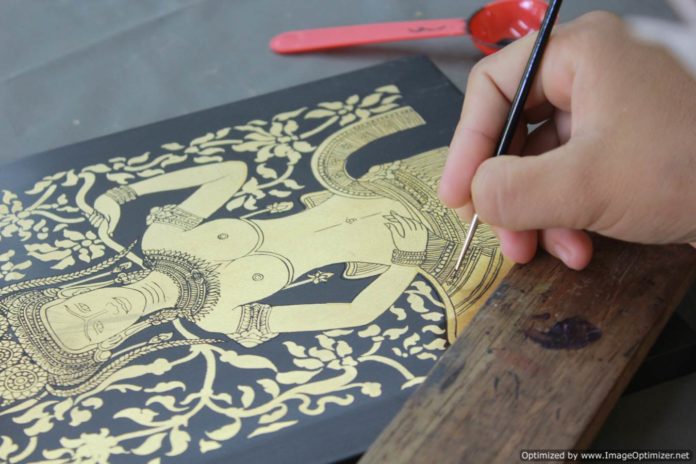Dating back about three thousand years in China, the art of lacquer rapidly spread to Southeast-Asia, and is thus one of the most ancient crafts in Asia. In Cambodia, traditional techniques of lacquerwork first aimed at protecting wooden houses, boats or kitchen utensils from damp and insects. Thereafter lacquer was used for the production of sacred objects, as well as for furniture, theater masks, musical instruments, and decorative items, as it serves as a protective coating for wood to make it more resistant. It was also notably used for painting, varnishing and polishing. Even though it was one of the most important forms of Cambodian craft in everyday life, tradition of lacquer work had been lost during the prolonged periods of Khmer Rouge war and was only recently revitalised in Cambodia.
Because of the nearing extinction of lacquer work in Asia, UNESCO organized in 1996 a conference in Myanmar where Asian lacquer specialists gathered to find ways to help the art of lacquer survive the many challenges it faces today. Documents resulted that inventoried procedures practiced in the past as well as the present, so that knowledge of raw materials and techniques would not be lost.
Cambodian lacquer resin is obtained by cutting the bark of a local dark-red tree named Melanorrhea laccifera. The accumulated resin is collected daily or every other day. The method of application hardly varies according to the medium used—often stone or wood. In the case of a lacquered wooden panel, several layers of black lacquer are first applied to a prepared wooden surface, which is consequently smoothed off from its original harshness. At least one day of drying time is needed between each application of layer, making it a lengthy process. The craftsman then applies colours onto the item and adorns it with copper-leaf gilding. Afterwards, the item is rubbed with sandpaper until flat and smooth, a task facilitated by adding water while polishing. Once the patina is applied, the lacquered product is finally polished by an artisan performing this operation with the palm of the hand.
Lacquer work is a time-consuming craft as the process requires precise workmanship and a lot of patience given the long drying periods and hours of polishing that are essential to lacquer art. Like several other artistic skills, the art of lacquer almost disappeared from Cambodia under the Khmer Rouge regime. It was only revitalised in the 1990’s thanks to international support in this field. Today, Artisans Angkor and Angkor Artwork, both located in the Siem Reap province, are the main organizations keeping the lacquer tradition alive in Cambodia.











